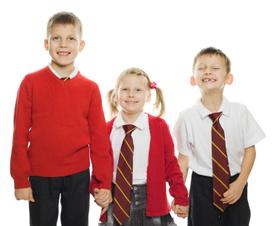Serving 424 students in grades 9-12, Clarke Community High School ranks in the bottom 50% of all schools in Iowa for overall test scores (math proficiency is bottom 50%, and reading proficiency is bottom 50%).
The percentage of students achieving proficiency in math is 42% (which is lower than the Iowa state average of 64%). The percentage of students achieving proficiency in reading/language arts is 55% (which is lower than the Iowa state average of 70%).
The student:teacher ratio of 14:1 is equal to the Iowa state level of 14:1.
Minority enrollment is 44% of the student body (majority Hispanic), which is higher than the Iowa state average of 29% (majority Hispanic).
Quick Stats (2025)
- Grades: 9-12
- Enrollment: 424 students
- Student:Teacher Ratio: 14:1
- Minority Enrollment: 44%
- Graduation Rate: ≥95% (Top 5% in IA)
- Overall Testing Rank: Bottom 50%
- Math Proficiency: 42% (Btm 50%)
- Reading Proficiency: 55% (Btm 50%)
- Science Proficiency: 45-49% (Btm 50%)
- Source: National Center for Education Statistics (NCES), IA Dept. of Education
Top Rankings
Clarke Community High School ranks among the top 20% of public schools in Iowa for:
Category
Attribute
Graduation Rate
School Overview
Clarke Community High School's student population of 424 students has grown by 8% over five school years.
The teacher population of 30 teachers has declined by 14% over five school years.
Grades Offered
Grades 9-12
(offers virtual instruction)
(offers virtual instruction)
Total Students
424 students
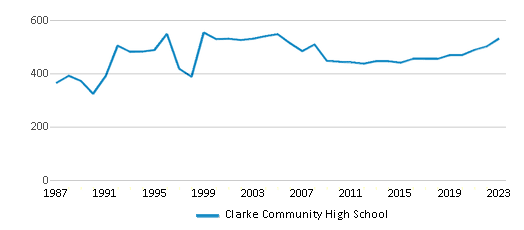
Gender %
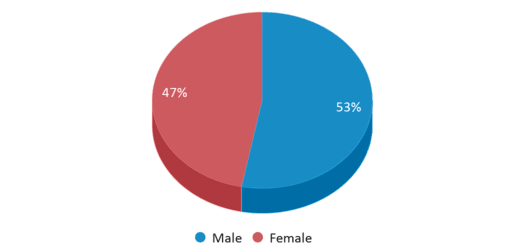
Total Classroom Teachers
30 teachers
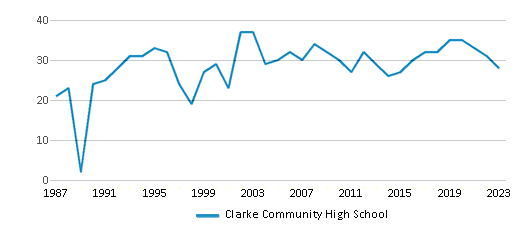
Students by Grade
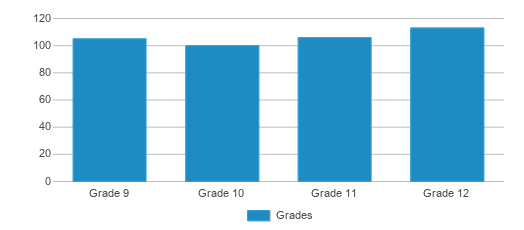
School Calendar
School Rankings
Clarke Community High School ranks within the bottom 50% of all 1,233 schools in Iowa (based off of combined math and reading proficiency testing data).
The diversity score of Clarke Community High School is 0.54, which is more than the diversity score at state average of 0.47. The school's diversity has stayed relatively flat over five school years.
Overall Testing Rank
#1113 out of 1233 schools
(Bottom 50%)
(Bottom 50%)
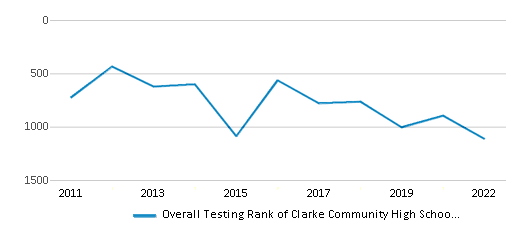
Math Test Scores (% Proficient)
42%
64%
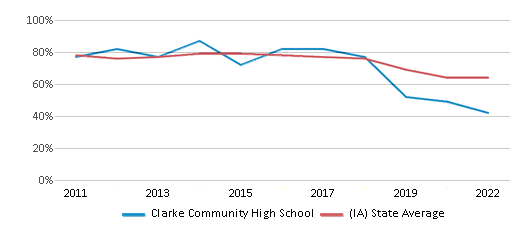
Reading/Language Arts Test Scores (% Proficient)
55%
70%
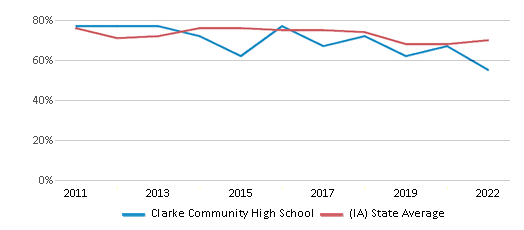
Science Test Scores (% Proficient)
45-49%
63%
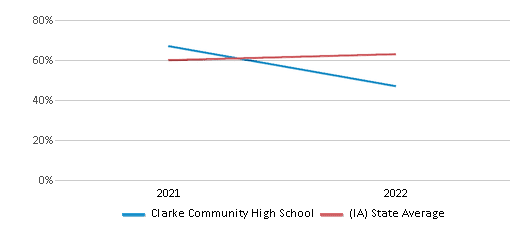
Student : Teacher Ratio
14:1
14:1
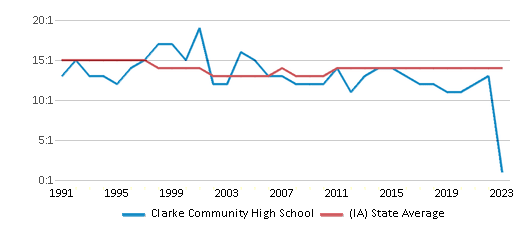
American Indian
n/a
n/a
Asian
1%
3%
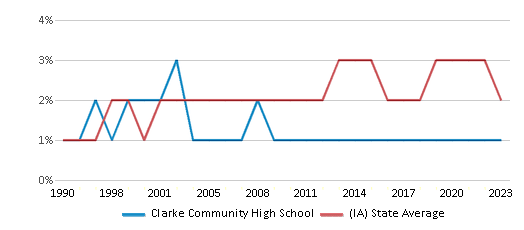
Hispanic
39%
13%
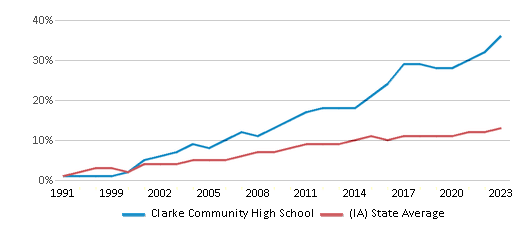
Black
1%
7%
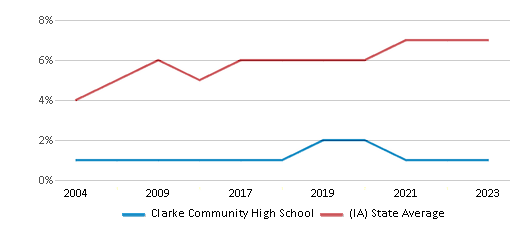
White
56%
71%
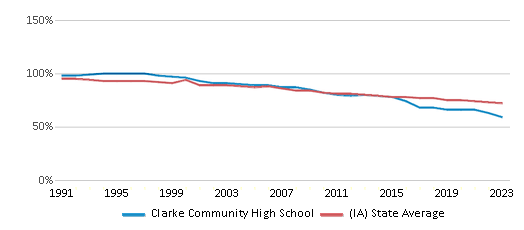
Hawaiian
1%
1%
Two or more races
2%
5%
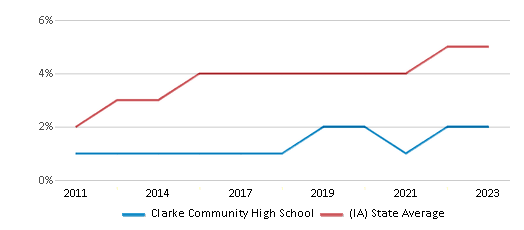
All Ethnic Groups
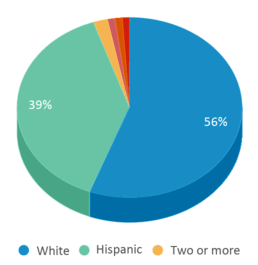
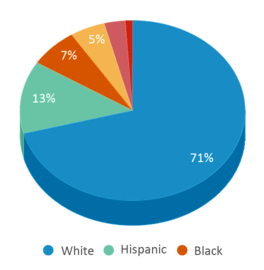
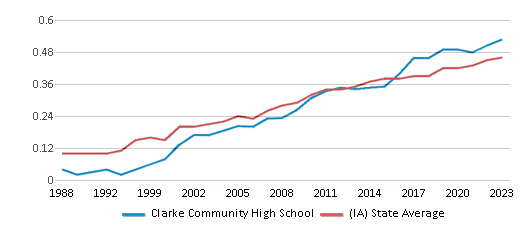
Graduation Rate
≥95%
90%
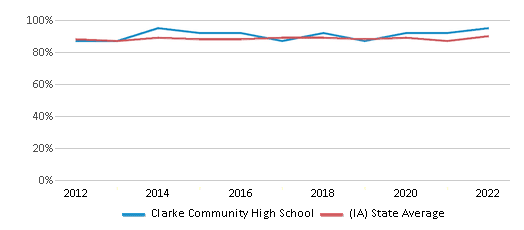
Participates in the National School Lunch Program (NSLP)
Yes
Eligible for Free Lunch
45%
36%
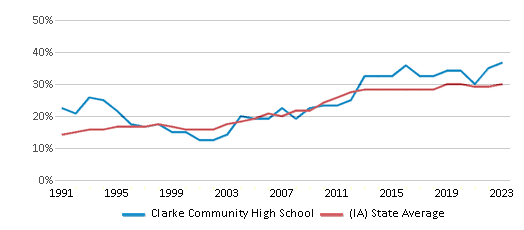
Eligible for Reduced Lunch
8%
5%
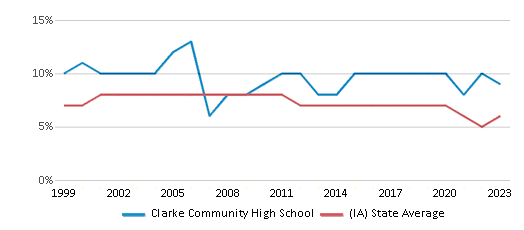
School Statewide Testing
School District Name
Source: National Center for Education Statistics (NCES), IA Dept. of Education
Profile last updated: 02/09/2025
Frequently Asked Questions
What is Clarke Community High School's ranking?
Clarke Community High School is ranked #1113 out of 1,233 schools, which ranks it among the bottom 50% of public schools in Iowa.
What percent of students have achieved state testing proficiency in math and reading?
42% of students have achieved math proficiency (compared to the 64% IA state average), while 55% of students have achieved reading proficiency (compared to the 70% IA state average).
What is the graduation rate of Clarke Community High School?
The graduation rate of Clarke Community High School is 95%, which is higher than the Iowa state average of 90%.
How many students attend Clarke Community High School?
424 students attend Clarke Community High School.
What is the racial composition of the student body?
56% of Clarke Community High School students are White, 39% of students are Hispanic, 2% of students are Two or more races, 1% of students are Asian, 1% of students are Black, and 1% of students are Hawaiian.
What is the student:teacher ratio of Clarke Community High School?
Clarke Community High School has a student ration of 14:1, which is equal to the Iowa state average of 14:1.
What grades does Clarke Community High School offer ?
Clarke Community High School offers enrollment in grades 9-12 (offers virtual instruction).
What school district is Clarke Community High School part of?
Clarke Community High School is part of Clarke Comm School District.
School Reviews
4 8/28/2019
You get what you put into the school. Both of my children graduated from Clarke and both went on to complete 4-year degrees, one in state at ISU and the other in Virginia at a private college. One of my students was dyslexic and the district worked to assist the student with their learning goals. Both of my children had enriching experiences and were active in the music and athletic programs. Is the district perfect? No. But the teachers genuinely care. If there are concerns, the staff is ready to work with you to come to a compromise. Active parenting and good communication with the school staff is needed at any school.
2 4/5/2010
Friends of my daughter have told her not to move or go to school there because of teacher who are not very nice
Review Clarke Community High School. Reviews should be a few sentences in length. Please include any comments on:
- Quality of academic programs, teachers, and facilities
- Availability of music, art, sports and other extracurricular activities
Recent Articles

What Is A Charter School?
Explore the world of charter schools in this comprehensive guide. Learn about their history, how they operate, and the pros and cons of this educational innovation. Discover key facts about charter schools, including admission policies, demographics, and funding, as well as what to look for when considering a charter school for your child.

10 Reasons Why High School Sports Benefit Students
Discover the 10 compelling reasons why high school sports are beneficial for students. This comprehensive article explores how athletics enhance academic performance, foster personal growth, and develop crucial life skills. From improved fitness and time management to leadership development and community representation, learn why participating in high school sports can be a game-changer for students' overall success and well-being.
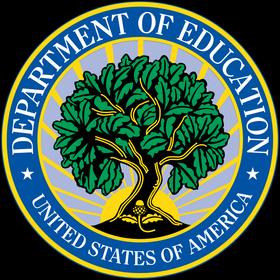
February 05, 2025
Understanding the U.S. Department of Education: Structure, Impact, and EvolutionWe explore how the Department of Education shapes American education, from its cabinet-level leadership to its impact on millions of students, written for general audiences seeking clarity on this vital institution.






